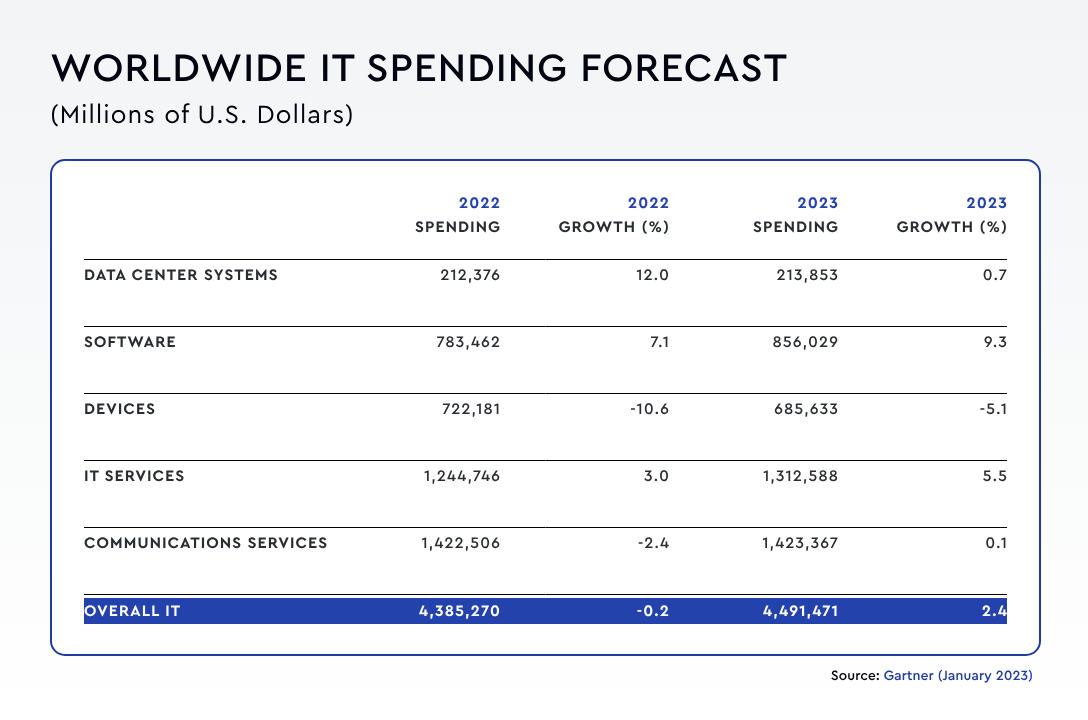[ad_1]
Amidst economic uncertainties, organizations need to be smart about their spending while gearing up for future growth. This makes financial management crucial for overall business operations, especially in IT.
\
In this article, I’ll offer 5 strategies for optimizing IT costs, drawing from my experience with top-performing global companies. I’ll share real examples of solutions and strategies that have increased efficiency and streamlined IT expenses for other organizations.
Current IT Spending State
In 2023, IT expenses reached $4.5 trillion, showing a 2.4% increase from the previous year, as per a Gartner report. Despite inflation affecting consumer spending on devices, there’s a notable rise in enterprise IT spending, particularly when investing in innovation and growth.
\n 
\
Finding this balance is an ongoing process that requires continuous focus during changing circumstances, needs, and capabilities. I can suggest 5 steps for enterprises to kickstart in improving IT cost efficiency.
1. Audit the Current IT Resources
In big companies, there are usually many different software solutions that need constant support, server setup, and sometimes, a dedicated team for ongoing improvements, resulting in extra IT costs. The challenge is keeping track, leading to two main issues:
\
- Duplicated efforts. Large companies tend to forget about existing solutions and invest in similar or duplicate solutions overlapping in functionality.
\
- Abandoned products. Some products that could have been valuable become outdated or inefficient, draining resources and hindering employee performance.
\
To tackle these issues, companies should audit their IT resources, assess application usage and spending, and consider consolidation or redesign. Audits should precede new software projects for rational resource use and ensure projects are necessary and valuable.
\
Sometimes, enhancing existing projects, finding similar products, or deciding not to invest may be better than starting a new project. This simple approach saves millions, optimizes investments, and generates revenue.
2. Think About a Digital Workplace
Enterprise growth drives the shift towards a digital workplace, acting as the company’s remote control to boost productivity. However, it’s crucial to note that digital workplaces aren’t a one-size-fits-all solution. There must be a specific need for a unified platform, replacing various disconnected systems.
\
From my experience, some businesses hesitate to embrace workplace transformation due to uncertainties about outcomes. This reluctance often results from a fear of the risks associated with comprehensive changes.
\
Common obstacles to implementing digital workplace initiatives include:
\
- Lack of digital skills and employee resistance
- Misalignment among company leaders
- Absence of an innovation-ready digital infrastructure
- Concerns about financial risks
\
By automating routine processes, organizing tasks under a digital workplace umbrella allows employees to focus on impactful work, reducing time spent on manual routines.
3. Streamline and Standardize IT Practices
Enterprise-wide IT inconsistencies can lead to long-term inefficiencies. Given the multitude of software solutions across departments, standardizing development practices becomes crucial.
\
- Systematization. Standardizing practices ensures consistency, predictability, and reliability in delivering software products. Specific standards for coding, testing, and deployment minimize workflow variations, simplifying overall management.
\
- Templatization. Using predefined structures for coding, testing, and documentation streamlines efforts, ensuring teams adhere to established norms and reducing time for repetitive tasks.
\
- Design standardization. Maintaining a uniform UI kit and consistent design standards improves readability. This ensures a unified approach among developers, facilitating faster releases of user-friendly software solutions.
\
A structured software development process creates a consistent IT cost optimization framework, avoiding redundant work and enhancing product quality with development speed.
4. Invest in Custom Enterprise Software
Large corporations can save money by creating their own internal software instead of paying for subscriptions and licenses. For example, the cost of a suite of basic productivity apps can add up significantly over time for businesses with many employees.
\
In such cases, developing a custom in-house suite of similar apps can be a more cost-efficient choice.
\
With a considerable number of employees, even a basic suite of licensed software will result in substantial expenses over the years. At this point, creating custom software becomes a more cost-effective solution. Despite the initial development investment and ongoing maintenance costs, it becomes a significant move for IT cost optimization, ultimately saving money in the long run.
5. Rethink Your Approach to Data
Big data and analytics are vital for IT cost reduction. However, using outdated or faulty data can complicate processes and hinder cost efficiency. For instance, relying on outdated data for tax filing policies can lead to errors and financial penalties.
\
Analyzing regularly updated datasets helps identify inefficiencies. Modernizing and consolidating data centers can save 10% to 20% of the overall budget.
\
Essential steps for efficiency and data center modernization include:
- Standardizing data input
\
- Consolidating data in a secure cloud-based space
\
- Automating real-time data processing
\
- Shifting from manual data entry
\
To sum up, implementing big data analytics enables data-driven decisions, optimizing operations and resources. Continuous modernization contributes to IT cost reduction, enhancing overall efficiency and competitiveness.
How to get Maximum Impact
As enterprises expand, optimizing IT costs becomes crucial. This frees up resources for innovation, propelling the company’s digital agenda and fostering further growth.
\
The listed strategies, particularly intelligent automation, play a defining role in current technological advancements and can significantly contribute to achieving IT cost optimization goals.
\
By leveraging the practices I listed above effectively, organizations can not only reduce unnecessary expenditures but also streamline processes, enhance productivity, and drive overall business performance.
[ad_2]
Source link

